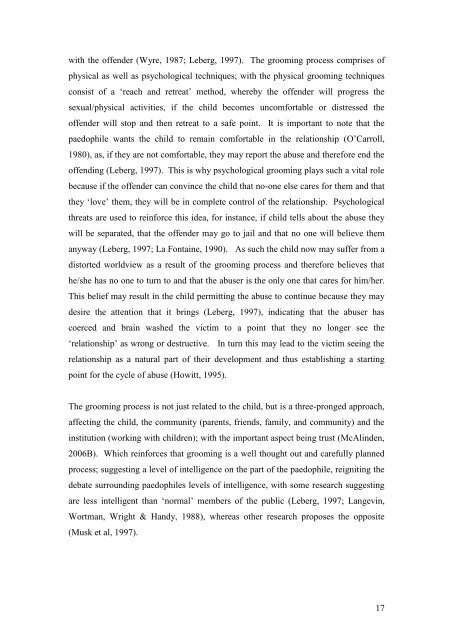McCartan, K. (2008) Current understandings of paedophilia and the ...
McCartan, K. (2008) Current understandings of paedophilia and the ...
McCartan, K. (2008) Current understandings of paedophilia and the ...
Create successful ePaper yourself
Turn your PDF publications into a flip-book with our unique Google optimized e-Paper software.
with <strong>the</strong> <strong>of</strong>fender (Wyre, 1987; Leberg, 1997). The grooming process comprises <strong>of</strong><br />
physical as well as psychological techniques; with <strong>the</strong> physical grooming techniques<br />
consist <strong>of</strong> a „reach <strong>and</strong> retreat‟ method, whereby <strong>the</strong> <strong>of</strong>fender will progress <strong>the</strong><br />
sexual/physical activities, if <strong>the</strong> child becomes uncomfortable or distressed <strong>the</strong><br />
<strong>of</strong>fender will stop <strong>and</strong> <strong>the</strong>n retreat to a safe point. It is important to note that <strong>the</strong><br />
paedophile wants <strong>the</strong> child to remain comfortable in <strong>the</strong> relationship (O‟Carroll,<br />
1980), as, if <strong>the</strong>y are not comfortable, <strong>the</strong>y may report <strong>the</strong> abuse <strong>and</strong> <strong>the</strong>refore end <strong>the</strong><br />
<strong>of</strong>fending (Leberg, 1997). This is why psychological grooming plays such a vital role<br />
because if <strong>the</strong> <strong>of</strong>fender can convince <strong>the</strong> child that no-one else cares for <strong>the</strong>m <strong>and</strong> that<br />
<strong>the</strong>y „love‟ <strong>the</strong>m, <strong>the</strong>y will be in complete control <strong>of</strong> <strong>the</strong> relationship. Psychological<br />
threats are used to reinforce this idea, for instance, if child tells about <strong>the</strong> abuse <strong>the</strong>y<br />
will be separated, that <strong>the</strong> <strong>of</strong>fender may go to jail <strong>and</strong> that no one will believe <strong>the</strong>m<br />
anyway (Leberg, 1997; La Fontaine, 1990). As such <strong>the</strong> child now may suffer from a<br />
distorted worldview as a result <strong>of</strong> <strong>the</strong> grooming process <strong>and</strong> <strong>the</strong>refore believes that<br />
he/she has no one to turn to <strong>and</strong> that <strong>the</strong> abuser is <strong>the</strong> only one that cares for him/her.<br />
This belief may result in <strong>the</strong> child permitting <strong>the</strong> abuse to continue because <strong>the</strong>y may<br />
desire <strong>the</strong> attention that it brings (Leberg, 1997), indicating that <strong>the</strong> abuser has<br />
coerced <strong>and</strong> brain washed <strong>the</strong> victim to a point that <strong>the</strong>y no longer see <strong>the</strong><br />
„relationship‟ as wrong or destructive. In turn this may lead to <strong>the</strong> victim seeing <strong>the</strong><br />
relationship as a natural part <strong>of</strong> <strong>the</strong>ir development <strong>and</strong> thus establishing a starting<br />
point for <strong>the</strong> cycle <strong>of</strong> abuse (Howitt, 1995).<br />
The grooming process is not just related to <strong>the</strong> child, but is a three-pronged approach,<br />
affecting <strong>the</strong> child, <strong>the</strong> community (parents, friends, family, <strong>and</strong> community) <strong>and</strong> <strong>the</strong><br />
institution (working with children); with <strong>the</strong> important aspect being trust (McAlinden,<br />
2006B). Which reinforces that grooming is a well thought out <strong>and</strong> carefully planned<br />
process; suggesting a level <strong>of</strong> intelligence on <strong>the</strong> part <strong>of</strong> <strong>the</strong> paedophile, reigniting <strong>the</strong><br />
debate surrounding paedophiles levels <strong>of</strong> intelligence, with some research suggesting<br />
are less intelligent than „normal‟ members <strong>of</strong> <strong>the</strong> public (Leberg, 1997; Langevin,<br />
Wortman, Wright & H<strong>and</strong>y, 1988), whereas o<strong>the</strong>r research proposes <strong>the</strong> opposite<br />
(Musk et al, 1997).<br />
17

















